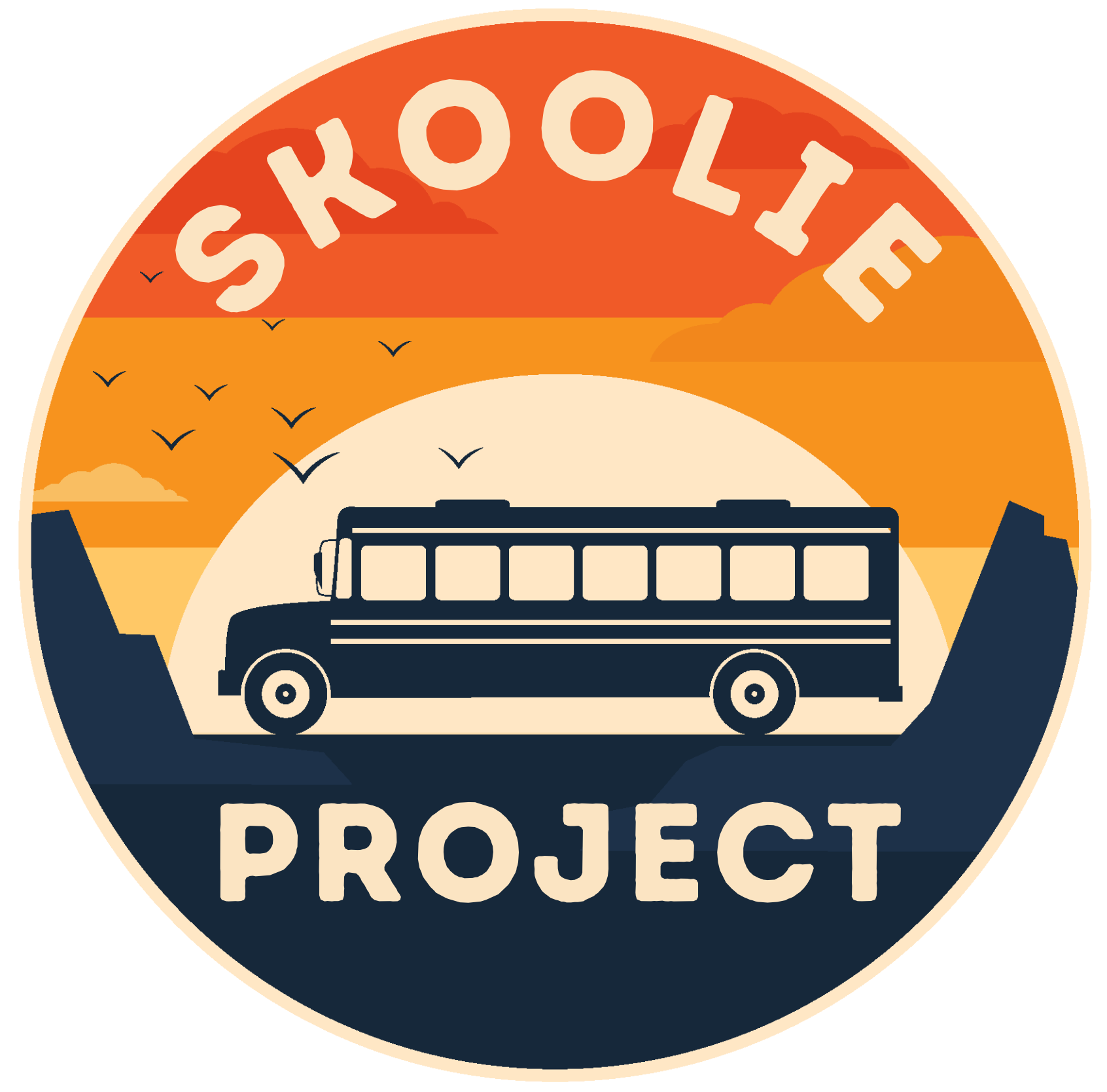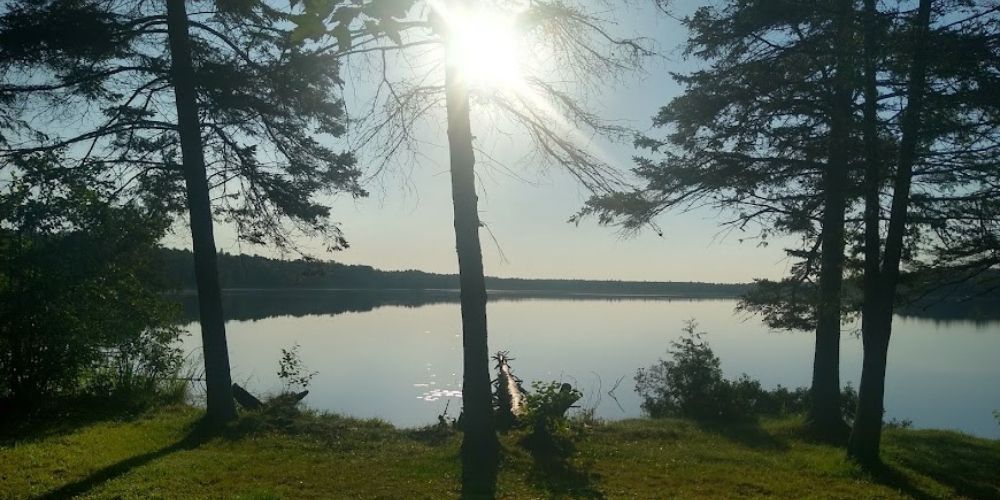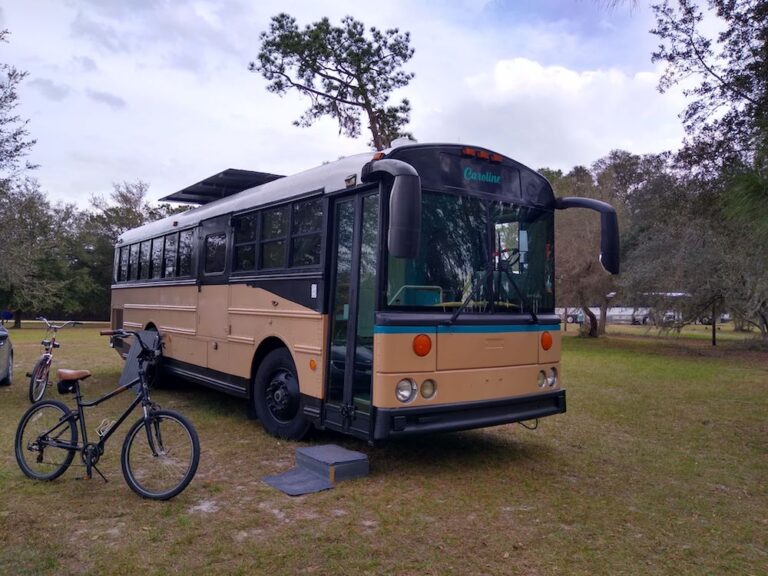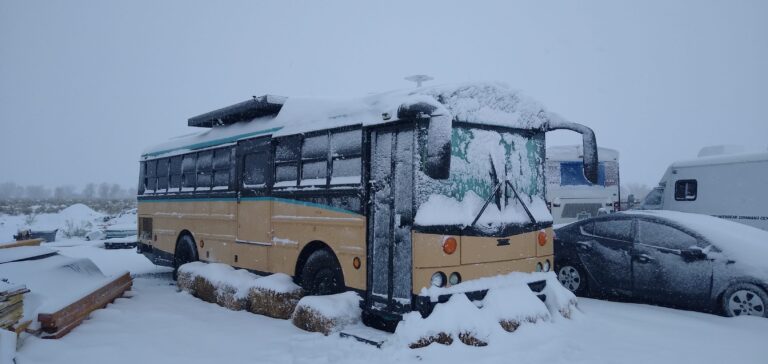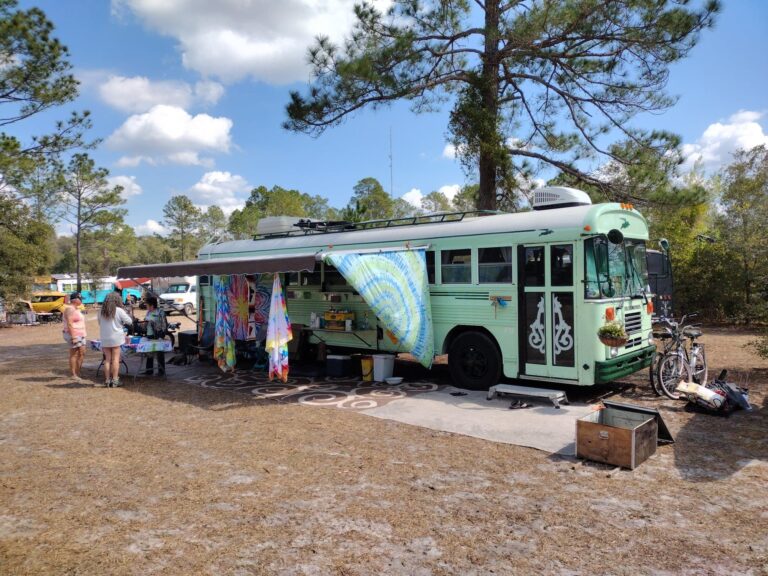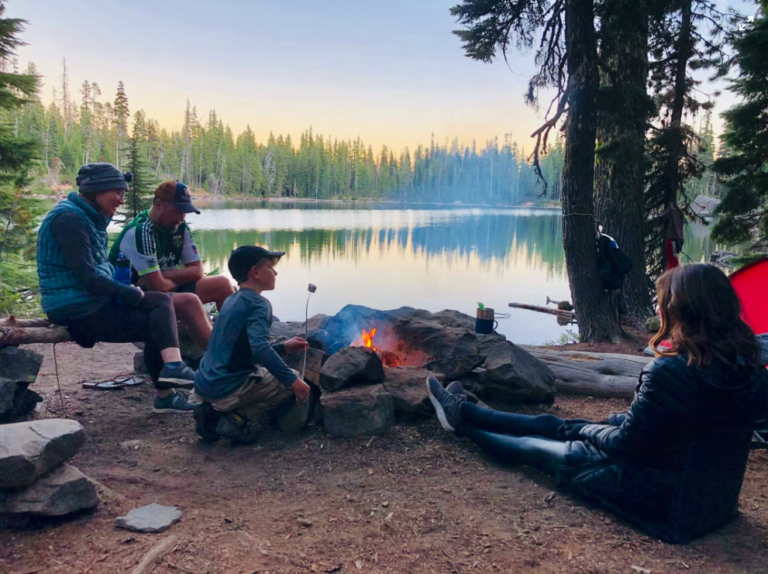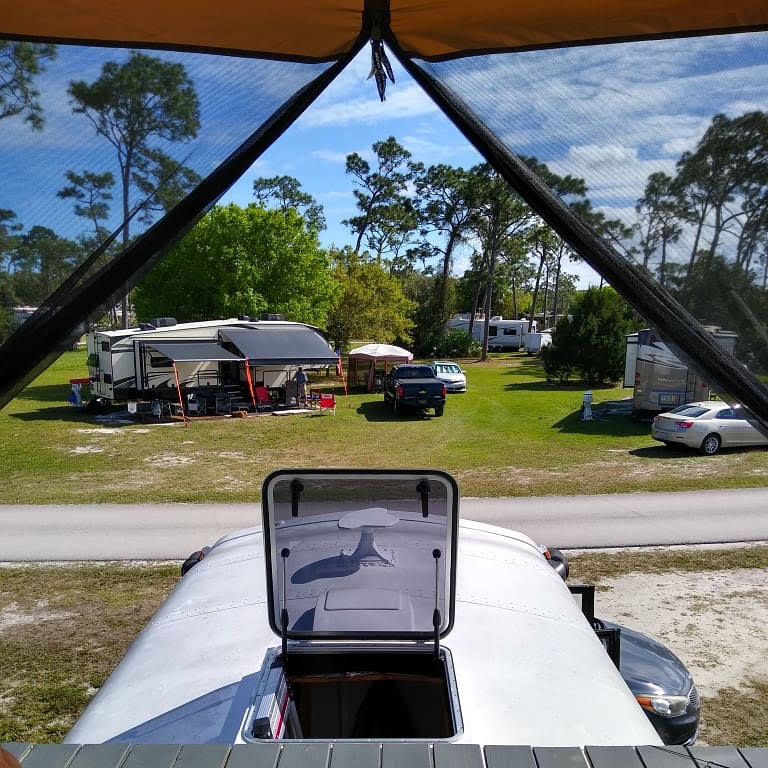10 Best Secrets To Set Up Your Skoolie Campsite
Setting up your skoolie campsite is one of the most important aspects of skoolie life. Especially when you are parking and camping in national or state parks, BLM land, or dispersed camping.
Having a set routine or checklist for setting up and breaking down your skoolie campsite will make life so much easier for you!
Granted, your campsite may look slightly different depending on when and where you may be camping, but having a process and procedure for setting up and breaking down your camp makes for a happy camper.
Before setting up your skoolie campsite, arrive before dark!
Arrive and Make Camp Before Dark.
This is one of the most important things for you to remember when it comes to setting up your skoolie campsite.
Arrive and make camp BEFORE dark.
Just last night, a couple in their DIY bus showed up where we are currently camping around 9 pm. We are way out in the country and it is dark at night here. It was very dark. They were in a 40-foot skoolie with a tow vehicle.
When they attempted to pull into the camping ground, they clipped one of the lumber poles at the entry.
Part of that is due to they had been driving for 13 straight hours.
The biggest part of it was they arrived after dark and had a hard time seeing their clearance into the entry gate.
Plan your trip and driving schedule according to when you want to arrive at your destination. Plan accordingly so that you arrive at your campsite well before evening.
Have a Checklist of Items and Safety For Your Skoolie Campsite
The other important aspect of setting up your skoolie campsite is to know your set-up and break-down process and checklist like the back of your own hand.
If you do not have it methodically memorized yet, then have a checklist on a sheet of paper or in digital form.
Do not pop a beer or pour a glass of wine until you have checked off everything on the skoolie campsite list. Know your process and why that process is critical for a successful campsite.
Why Is It Important To Have a Routine For Setting Up My Skoolie Campsite?
Having a routine for setting up your skoolie campsite is one of the best favors you can do for yourself.
For those who just “wing it” and have no process, procedure, or routine that has been implemented, then setting up your skoolie campsite is hit or miss and somewhat chaotic.
Sometimes our audacity gets in the way of practicality and common sense.
Unless you have your skoolie campsite setup memorized and ingrained into your DNA, not adhering to that process and procedure is illogical and audacious.
Perfect the skoolie campsite setup and you will be able to enjoy camping so much more.
We still go by our skoolie campsite checklist and we have been doing this since 2019 full-time. Over 30,000 miles traveled and 39 states visited.
When we have not followed our skoolie campsite checklist, we have forgotten things and the process itself is stressful.
Skoolie life isn't supposed to be stressful! Don’t make it stressful! It goes against everything we are all looking for in life. Eliminate the stress and be smart when it comes to setting up as well as breaking down your skoolie campsite.
Position Your Bus For Solar
If you are relying on solar for your electricity, then be sure to position your skoolie to maximize the rise and fall of the sun throughout the day.
Unless of course, you have tilting solar panels and can position them independently.
This should be at the very top of your skoolie campsite checklist.
Having your skoolie positioned to maximize your sun intake will save you from repositioning your bus when you realize that half the day you are shaded by trees or other obstacles.
Do it right the first time and you won’t have to do it again until you move to your next skoolie campsite.
Leveling Your Bus
If you are already on level ground, you can skip this part of your campsite setup. If you are tilting from left to right or if the rear or sleeping end of your bus is lower than where your feet will be, you need to level up.
If you are not already level, this should be the very next item on your skoolie campsite checklist.
You don’t want to sleep with your head lower than your feet. You will wake up with a headache.
Also, you don’t want cabinets or drawers opening all by themselves because your bus is tilting.
Level it out with whatever you use for leveling blocks to make the most of your camping situation and experience.
Chock Your Tires
Whether you are on a slope, incline, or hill, it is important to chock your tires as a part of your skoolie campsite setup routine. This is a huge safety concern when setting up your skoolie campsite.
If you do not already have a good set of wheel chocks, then that is something you will want to add to your Skoolie Gear!
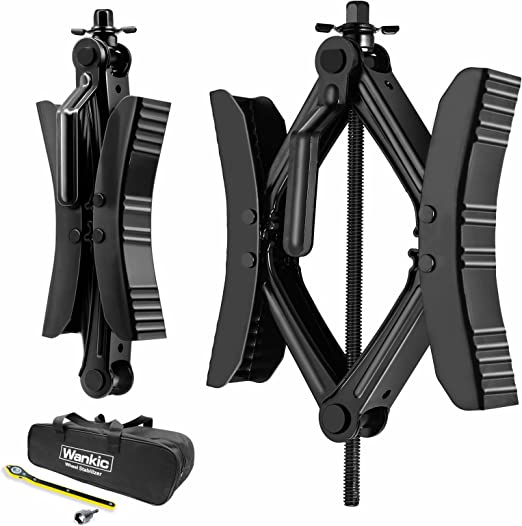
The reason it is important, is when you are parked and camping on uneven ground and your tires do need to be choked, it will just be a natural part of your campsite setup routine.
Walk Your Skoolie Campsite Area
When you arrive at your campsite you want to spend a few days or a few weeks at, be sure to walk the perimeter of your campsite.
Depending on where you are camped, we suggest you walk a minimum of 200 feet in circumference.
There are several things to pay attention to while surveying and walking the campsite.
Keep a sharp eye out for animal tracks, “rub trees” from grizzly bears, bears, lions, or wolf scat. Moose or elk rutting, wasp or hornet nests, dead limbs, signs of flash floods.
Get a good “feel” if the area feels right for your stay. If something does not look or feel right, move on to another spot.
Pay Attention to Overhead Limbs
If you are camping where there are trees, and especially, trees over your skoolie or over where your hammock, firepit, and chairs are located, be on the lookout for dead limbs.
Don’t let the size of a limb fool you either. There may be a dead-looking limb high above you, but you may think it is too small to injure you or damage your skoolie.
Wood, dead or partially dead can be very dense. Depending on the type of wood, a dead limb can do some serious damage. The higher up it is, the more damage it will cause. It’s all simple physics.
Check For Signs of Flash Flood Evidence
If you are camping in the desert or on or near any substantial hills or mountains, then look and survey the area for signs of flash floods.
You can tell if there are flash floods near and around you by subtle and sometimes obvious clues.
Signs of prior flash floods will be large boulders, tree limbs, or unnatural debris laying on top of a dried-up creek bed.
When camping in the mountains, be aware of unusually warm days while there is still a good bit of snow on the mountains. Melting snow can accumulate quickly into a flash flood situation.
Small innocent creek beds can become dangerous rivers in a very short time.
When camping in the desert, keep a close eye on gulleys and dried-up creek beds during a rainstorm. A dried-up creek bed can go from nothing to a swift river in no time.
Check For Signs of Wildlife
We’ve mentioned this briefly, but checking for signs of wildlife is something you want to pay attention to. Remember, you are camping in their neighborhood.
This is their turf, so we must be respectful to keep ourselves and them safe.
If you do not respect wildlife and nature, then you have no business camping in the bush. Never let us witness anyone disrespecting wildlife. We do not tolerate it at all.
Not all wildlife is dangerous. That being said, any wild animal has the potential to cause you or a member of your family harm under the right circumstances.
That is why it is so important when camping out in the “wild” to be vigilant about your surroundings and stay alert at all times. Relax and have fun, just be smart and have situational awareness of your surroundings.
Check for Signs of Wild Animals
Knowing what kind of wildlife you may encounter when camping in an area is quite wise. The chances of you having a direct encounter with a wild animal are rare, but not impossible.
Understanding what types of wild animals live around your campsite is the first step in preparation to protect you, your family, and your pets. Not to mention protecting the wild animal from potential harm.
The animals below pose the biggest safety threat to you. Look for the following signs of evidence of these animals moving across your campsite.
There are ways to avoid poor decisions and unfortunate encounters with wild animals. The National Parks Conservation Association offers some sound advice on avoiding wild animal encounters.
If you see any signs of these animals, there is a good chance you will see them again in the near future.
Bear Tracks & Scat

Wolf & Coyote Tracks & Scat
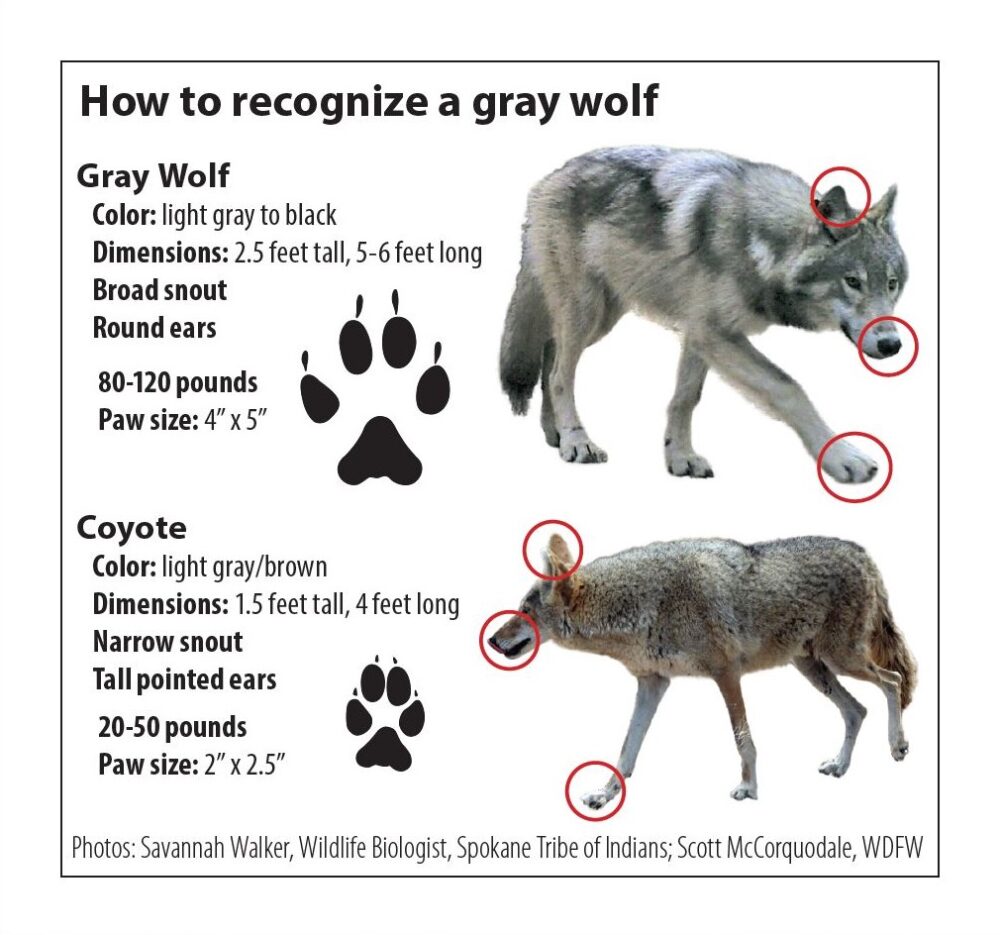
Mountain Lion & Scat
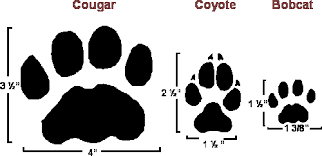
Just because these animals may call the area you are camping in-home, doesn’t mean they are a threat to you. People want more to do with wild animals than the animals want to do with you.
That is of course until a person has pissed the animal off, and then it is a disaster for both parties.
Stay safe and stay smart, leave the wildlife alone. You are not Steve Irwin!
Clear Your Skoolie Campsite Area
There are a few reasons it is a good idea to clean up and clear around your skoolie campsite. It provides a clean and distinct area and perimeter of your campsite for others who may wander into your campsite.
It also eliminates the surprise of walking up on a venomous snake. By raking up and clearing around your campsite, you have a clear view of what is on the ground around you. This will protect you and your pets.
A practical and logical reason for clearing your campsite of leaves, pine straw, twigs, and branches is to avoid an unexpected fire jump from your fire pit or fire ring.
With nothing dry and combustible around your fire pit, a fire starting where you do not want it to start is unlikely.
Rake Up Leaves and Pinestraw
Raking up leaves or pine straw from around your campsite may eliminate pesky rodents and venomous snakes from getting too close or into your skoolie.
Leaves are a great hiding place for snakes and rodents. Once a rodent gets the whiff of food inside of your skoolie, they will want to investigate.
If rodents are nearby, you can guarantee that snakes are nearby as well.
Besides, having your campsite raked up gives it a clean look and will make you feel better about your camp as well.
Relocate and Gather Wood
If there are dead limbs, branches, and wood laying around your campsite, carefully relocate it to one spot. Placing it by your firepit is a good option so as to burn it off naturally and safely.
Be very careful when handling firewood, logs, or branches in the wild. Venomous snakes, spiders, and scorpions love to make wood piles their homes. Always use a thick, safe pair of gloves when picking up or handling wood in the wild.
Setup up Your Outdoor Lounge Area
Setting up your outdoor lounge area is where you are going to be spending at least half of your time. So, you are going to want it to be functional, comfortable, and safe.
There are some essential skoolie items you are going to want for your outdoor lounge area.
- Rug
- Awning
- Chairs
- Table
- Hammock
Build Your Fire Pit
Building a firepit should be one of the steps after arriving at your campsite. Getting a warm fire going makes everything feel better, like being at home.
When deciding on where to locate your fire pit or fire ring, be sure to set it up no closer than 6 feet from your rig.
There should be no low-hanging libs or branches and nothing that can naturally combust within 3 feet of the fire.
Having a Jerry can of water nearby is also advisable to squash any fire you do not want to burn.
Outdoor Cooking Station
Cooking outdoors is one of the most enjoyable and primal experiences we love about camping in the bush.
Depending on the area you are camping in, there are some important safety rules to live by.
If there are bears, black, brown, or especially grizzly bears, never cook or leave your outdoor kitchen set up by your bus.
The smells can be detected more than a mile away from a bear.
When preparing, or storing your food and cookware, be sure to clean it thoroughly, or hang it no less than 15 feet above the ground and 200 feet from your bus.
The same goes for raccoons, although, they are not as dangerous.
If you are tent camping, never sleep in the clothes you cooked with when camping in bear or wolf country.
Leave No Trace of Food
As we mentioned above, always remember the following when preparing and cooking food in the wilderness.
- Check with the Park Ranger or park rules for proper food storage. Most national and state parks require the use of a bear bag or bear box.
- Keep a minimum o 200 feet from your meal prep and cooking stations and your skoolie
- Do Not store food, dirty dishes or cookware less than 200 feet from your skoolie
- Never sleep in clothes worn while cooking, especially if you are outside or tent camping.
- You should Never feed wildlife. Yes, it is tempting and you feel like you are connecting with the animal. However, this is more dangerous for the animal in the long run than it is for you.
You may think you are doing a wild animal a favor by feeding it something small. You may feel like you are connecting with the animal by having a “moment” with it.
However, when you leave, that animal is going to associate other humans with a free hand out of food. Not all humans are as kind to wild animals as you and may end up feeding it something that will hurt it.
Others may try to capture the animal and keep it as a pet.
While sometimes, the animal may end up unintentionally injuring another human, and now it is marked for death by the authorities.
Just do yourself and mostly, the wild animals, a favor and do not feed them. Keep them wild, it is the safest existence for them.
Pooping and Peeing Near Your Skoolie Campsite 💩
We are not going to go too deep on where, when, and how to pee and poop in, around or near your skoolie campsite. We have already gone into a deep conversion on that topic all by itself.
You can read about how to safely and effectively Pee and Poop In Your Skoolie here.
We will touch on it here because it is an important step in setting up your skoolie campsite.
Once you have scoped out the immediate area of your skoolie campsite for signs of wild animals, reptiles, and potentially dangerous insects, like fire-ants, you should begin to look for a spot where you may want to go poop outside. 💩
Don’t misunderstand us, we are not encouraging you to pee or poop outside, but if the need should arise, there are certain rules and courtesies you should follow.
Always pee or poop 💩 at least 200 feet from your campsite. That is approximately 70 adult normal footsteps from the outer edge of your skoolie campsite.
The reason for this is in part due to wild animals as well as not contaminating your campsite with bad smells. 💩
Find that special spot and note it in the event you need to go do your business outside.
Breaking Down Your Skoolie Campsite
When it is time to leave or move your campsite, there should be a methodical and organized process and procedure for breaking down and packing up your campsite.
Having a routine that you consistently use to breakdown and pack up your campsite will ensure:
- Prevents you from getting stressed out
- You aren’t as likely to forget and leave something behind
- Your skoolie is packed up and organized so you know where everything is
- When you set up your next campsite, you are organized, and setting up camp is much easier and more organized
When packing all of your campsite gear away, do it in reverse order, so everything is in its proper order when it is time to set up camp again.
Leave Your Skoolie Campsite Better and Cleaner Than You Found It
This is something all of our mommas taught us growing up. Some of us listened, and unfortunately, some of us did not.
It is not a hard thing to do. Simply clean up your mess before you leave. Think of the Golden Rule. Treat others the way you would want them to treat you.
Leave your campsite the way you would want to roll upon it and find it yourself.
If it was dirty, messy with the trash left behind when you arrived, clean that mess up before you leave. Be a responsible human being and just do the right thing.
Our running motto for the last decade or so is simple. “Don’t Be A Dick.”
Substitute whatever noun you feel comfortable with or appropriate there. Just leave your skoolie campsite better than you found it.
We are all ambassadors to this community and lifestyle. If you want people to think skoolie owners are trashy, irresponsible dicks, then continue to propagate that stereotype.
If you want to prevent that stereotype from continuing or evolving, then do your part. That’s all.
Wrap Up To Setting Up Your Skoolie Campsite
Camping, especially for two to three weeks at a time, is one of the things we love most about this nomadic lifestyle. Being able to just sit still in one area and explore and enjoy all that it has to offer.
From the natural and beautiful wilderness to mom-and-pop-owned restaurants and shops in local small towns.
Part of that enjoyment is having a systematic and organized system of setting up our skoolie campsite as well as breaking it down and packing up.
We have done it on the “fly” before. Just “winging” it and getting it done in no particular order or fashion.
When we have done it on the “fly”, it seemed like everything never quite fit right in our storage or garage area.
When we unpack and re-pack our campsite in a methodical and organized procedure, everything fits and goes into its place like a simple jigsaw puzzle.
How do you set up your campsite? Do you have a system in place or do you just wing it? Leave us a comment, we’d love to hear and connect with you!
